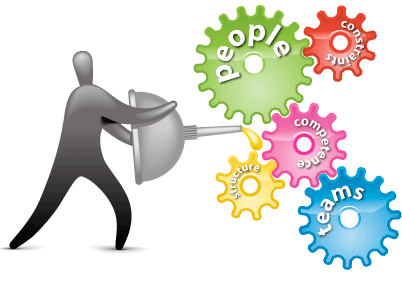 What’s The Big Idea?
What’s The Big Idea?
How many of us look forward to the traditional annual performance review? I mean really, whether you are on the presenting or receiving side of things… it is not the highlight of the year for anyone I know. I believe there’s a better way.
As individuals on a team, we can benefit greatly from more frequent, more relevant feedback loops.
And while real-time feedback wraps do wonders on a 1-1 basis, I’m finding additional value in on-demand as well as periodic (quarterly/) roundtable reviews.
Following is an approach I’ve rolled out for teams I serve. It’s intentionally on the structured side – providing a framework of safety suitable for shu and ha-level teams.
The approach is based on the values and principles of the Agile Performance Appraisals Manifest and the following beliefs:
- Performance review of the team is the responsibility of everyone on the team
- Accountability comes from within the team
- Trust and safety are not served by anonymity
- Individual performance review should be an open conversation among all members of the team
Format for Peer Round Table Performance Review
In a round-table peer review, several (min 3, max 9) members of a team provide face-to-face feedback on the performance of an individual teammate, the “reviewee.” Participation is 100% voluntary for all. (Note: Given organizational constraints, it may be appropriate to have the reviewee’s manager only observe, but not actively participate in the roundtable. Check with your HR folks. Yeah, sigh.)
A facilitator (could be the team’s coach or scrum master) guides the session and keeps to a specific format that:
- Maintains a safe, effective environment
- Enables productive giving and receiving of feedback
- Enhances transparency, trust, and honesty within the team
- Promotes co-generation of ideas for continuous improvement
Step 1: Facilitator Open
The facilitator:
- Provides a brief overview of the performance review sequence (outlined below)
- Invites a participant to read aloud the team’s mission statement -“Why we exist”(they have one, right?!)
- Reviews the values and principles of the Agile Performance Appraisals Manifest. (I typically read the four value pairs and then ask the participants to read the principles.)
Step 2: Self Review
The facilitator then invites the reviewee to answer the following three questions (and records the answers):
- In the context of this team, what are your most significant strengths? (Your “forehand”)
- In the context of this team, what are your most significant area(s) for development/growth? (Your “backhand”)
- Looking forward, how can the team help you enhance his/her impact on the team? (“Guardrails,” “Alliances,”)
Step 3: Team Feedback
Each participating team member then verbally gives their feedback to the reviewee, following similar questions:
- In the context of this team, what are the reviewee’s most significant strengths?
- In the context of this team, what are the reviewee’s most significant area(s) for development/growth?
- Looking forward, how can the team help the reviewee enhance their impact on the team?
The facilitator may offer a few reminders at the outset of this step
- The feedback is to be constructive and professional and about getting better a something
- Find ways to state feedback affirmatively if possible. (“Sunshine” to help the reviewee grow)
- What improvements/changes would make the biggest difference to the team / the organization?
- What contributions could the individual make that would have the most impact?
- What might they strive to get better at in order to make those contributions? (e.g, Instead of suggesting they stop some behavior, name what they might do instead. “Being less controlling” is not a good suggestion, it’s an outcome. “Getting better at giving more control to others” would be better.)
- What would enable them to serve the team better?
- Don’t say anything that you wouldn’t mind being on the receiving end of (assuming it’s true).
- The facilitator will record all of the feedback for the reviewee
- Reviewee is free to take notes but does not need to
- There is no rebuttal or inquiry by the reviewee on any of the feedback
- The only valid initial response by the reviewee to feedback is along the lines of: “Thanks, I appreciate the feedback.”
Step 4: Clarifying Questions
Once all participating team members have provided their input, the reviewee can then ask clarifying questions.
Typical clarifying questions are exploratory and come from a place of curiosity and inquisitiveness – not defensiveness.
For example:
- Tell me more about _____
- What part about _______ is confusing/surprising/annoying?
- How do you really want _______ to be?
- is there a relationship between X and Y?
- How did ____ affect you?
Step 5: Request for Advice
The reviewee has the option to request a round of advice from the team about an area they consider to be a top personal development priority.
Some examples:
- What would an experiment look like?
- What’s already working that I can build on?
- What’s the worst/best that could happen?
- How else could I handle ______?
Step 6: Reviewee Self-Summary
The reviewee then speaks to the highlights and takeaways from the feedback they have received.
If further discussion needs to happen amongst team members about any of the feedback, the reviewee will make that request by saying “I’d like to address topic x with person y outside of this format” and/or “I’d like to address topic x with the team.”
Step 7: Facilitator Close
The facilitator closes out the review session, thanking all participants for showing up with their whole selves and dismisses the meeting.
Round Table Review Followup
The feedback received will only help change things forward to the extent that it gets acted upon.
Within a week after the round table review, the reviewee and their manager and/or coach will have a 1-on-1 to talk about the feedback received, as well as plans for the reviewee’s long-term development and growth. Perhaps items are added to the teams’ continuous learning matrix.
How many of us look forward to the annual performance review? Whether you are on the presenting or receiving side of things... is it the highlight of the year? Share on XAgile Outcomes and Capabilities
Leaders and managers shift expectations from individual performance to supporting and encouraging whole-team performance measures and outcomes.
